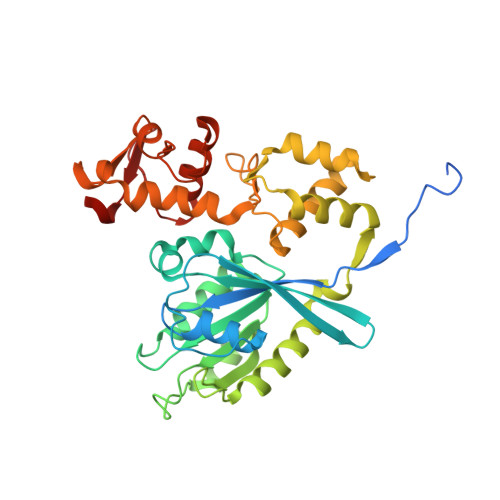Revisiting the Roco G-protein cycle.
Terheyden, S., Ho, F.Y., Gilsbach, B.K., Wittinghofer, A., Kortholt, A.(2015) Biochem J 465: 139-147
- PubMed: 25317655
- DOI: https://doi.org/10.1042/BJ20141095
- Primary Citation of Related Structures:
4WNR - PubMed Abstract:
Mutations in leucine-rich-repeat kinase 2 (LRRK2) are the most frequent cause of late-onset Parkinson's disease (PD). LRRK2 belongs to the Roco family of proteins which share a conserved Ras-like G-domain (Roc) and a C-terminal of Roc (COR) domain tandem. The nucleotide state of small G-proteins is strictly controlled by guanine-nucleotide-exchange factors (GEFs) and GTPase-activating proteins (GAPs). Because of contradictory structural and biochemical data, the regulatory mechanism of the LRRK2 Roc G-domain and the RocCOR tandem is still under debate. In the present study, we solved the first nucleotide-bound Roc structure and used LRRK2 and bacterial Roco proteins to characterize the RocCOR function in more detail. Nucleotide binding induces a drastic structural change in the Roc/COR domain interface, a region strongly implicated in patients with an LRRK2 mutation. Our data confirm previous assumptions that the C-terminal subdomain of COR functions as a dimerization device. We show that the dimer formation is independent of nucleotide. The affinity for GDP/GTP is in the micromolar range, the result of which is high dissociation rates in the s-1 range. Thus Roco proteins are unlikely to need GEFs to achieve activation. Monomeric LRRK2 and Roco G-domains have a similar low GTPase activity to small G-proteins. We show that GTPase activity in bacterial Roco is stimulated by the nucleotide-dependent dimerization of the G-domain within the complex. We thus propose that the Roco proteins do not require GAPs to stimulate GTP hydrolysis but stimulate each other by one monomer completing the catalytic machinery of the other.
Organizational Affiliation:
*Department of Cell Biochemistry, University of Groningen, Nijenborgh 7, 9747 AG Groningen, The Netherlands.


















